
PLATO: How an educational computer system from the ’60s shaped the future
Forums, instant messaging, and multiplayer video games all started here.
by Cameron Kaiser – Mar 17, 2023 5:30am CST
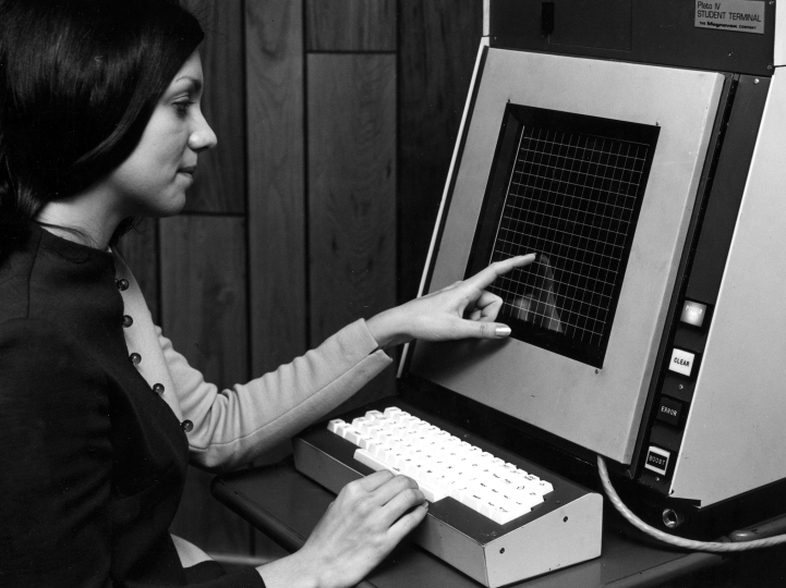
PLATO IV Terminal, ca. 1972-74.
University of Illinois Archives
Bright graphics, a touchscreen, a speech synthesizer, messaging apps, games, and educational software—no, it’s not your kid’s iPad. This is the mid-1970s, and you’re using PLATO.
Far from its comparatively primitive contemporaries of teletypes and punch cards, PLATO was something else entirely. If you were fortunate enough to be near the University of Illinois Urbana-Champaign (UIUC) around a half-century ago, you just might have gotten a chance to build the future. Many of the computing innovations we treat as commonplace started with this system, and even today, some of PLATO’s capabilities have never been precisely duplicated. Today, we’ll look back on this influential technological testbed and see how you can experience it now.
From space race to Spacewar
Don Bitzer was a PhD student in electrical engineering at UIUC in 1959, but his eye was on bigger things than circuitry. “I’d been reading projections that said that 50 percent of the students coming out of our high schools were functionally illiterate,” he later told a Wired interviewer. “There was a physicist in our lab, Chalmers Sherwin, who wasn’t afraid to ask big questions. One day, he asked, ‘Why can’t we use computers for education?’”
Ars Trending Video
ARS VIDEO
How The Callisto Protocol’s Animations Came To Life With Motion Capture
null
The system should be, in Sherwin’s words, “a book with feedback.”
The question was timely. Higher education was dealing with a massive influx of students, and with the Soviets apparently winning the space race with Sputnik’s launch in 1957, science and technology immediately became a national priority. “Automatic teaching,” as it was conceived, attracted interest both from academia and the military. Sherwin went to William Everett, the dean of the School of Engineering, who recommended that fellow physicist Daniel Alpert, head of the Control Systems Laboratory, assemble a group of engineers, educators, mathematicians, and psychologists to explore the concept. But the group ran into a serious roadblock in that the members who could teach were unable to comprehend the potential technologies required, and vice versa.
Alpert became exhausted after several weeks of fruitless discussion and was about to terminate the committee until he had an offhand discussion with Bitzer, who claimed to already be “thinking about ways to use old radar equipment as part of an interface for teaching with a computer.” Using grant funding from the US Army Signal Corps, Alpert gave him two weeks, and Bitzer went to work.
For the actual processing, Bitzer used the University’s pre-existing ILLIAC I (then just “ILLIAC”) computer. It was the first computer built and owned entirely by an educational institution, and it was a duplicate of the slightly earlier ORDVAC. Both were built in 1952, and they had full software compatibility. IILIAC’s 2,718 vacuum tubes gave it more computing power than even Bell Labs had in 1956, with an addition time of 75 microseconds and an average multiply time of 700 microseconds, 1024 40-bit memory words, and a 10,240-word magnetic drum unit. Bitzer worked with programmer Peter Braunfeld to design the software.
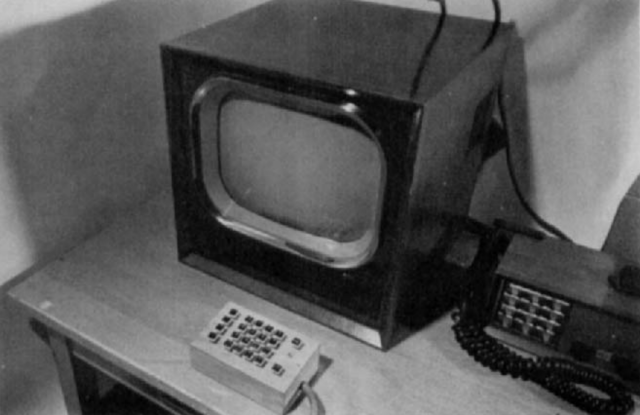
Enlarge / PLATO I terminal in 1960.
The Wide World of Computer-Based Education (Bitzer, 1976)
The front end was a consumer TV set wired up with a self-maintaining storage tube display and a small keypad originally used for the Naval Tactical Defense System. On-screen slides appeared from a projector under ILLIAC’s control and were manipulated by the control keys, and ILLIAC could overlay the slides with vector graphics and text at 45 characters per second via what Bitzer and Braunfeld called an “electronic blackboard.” The system offered interactive feedback at a time when most computer interaction was batched. The computer was christened PLATO in 1960 and was later backronymed as “Programmed Logic for Automatic Teaching Operations.” Only one user could run lessons at a time, but the prototype worked.

Enlarge / PLATO II block diagram.
US Office of Naval Research’s Digital Computer Newsletter, October 1961-April 1962
The concept rapidly expanded. In 1961, PLATO II emerged, offering a full alphanumeric keyboard, plus special keys based on the PLATO I’s. These keys included CONTINUE (next slide), REVERSE (previous), JUDGE (check if an answer is correct), ERASE, HELP (for supplementary material or to reveal the answer), and the interesting AHA key for when the student might “suddenly realize the answer to the main-sequence question” and decide to answer it immediately.
Advertisement
Its biggest innovation, though, was time-sharing, allowing multiple students to use the system simultaneously for the first time. Careful programming was required for user time slices so that each session would not drop keystrokes. Unfortunately, ILLIAC’s memory capacity held back this advance, limiting system capacity to just two users at a time and restricting interactivity by capping “secondary help sequences.”
Advertisement
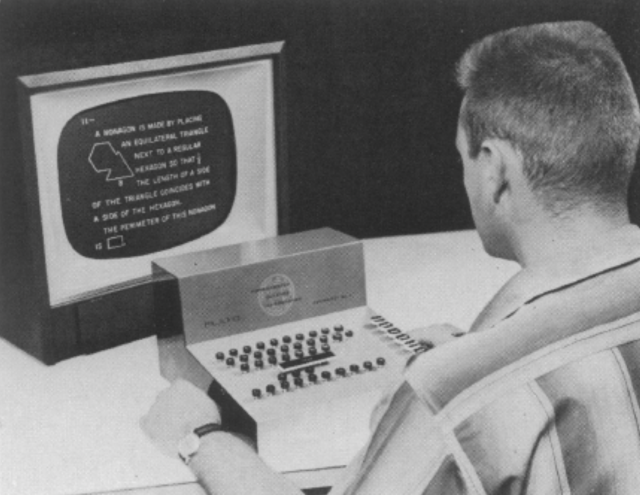
Enlarge / PLATO II terminal in 1961.
A Little History of e-Learning (preprint, Cope & Kalantzis, 2021)
ILLIAC I was decommissioned in 1963, and PLATO was re-worked yet again. By now, though, the idea was picking up steam and started to attract more funding and outside involvement. The forward-looking architecture of PLATO III took nearly six years to create, starting with a refurbished Control Data Corporation (CDC) 1604 donated the same year to the PLATO group by CDC’s progressive CEO and co-founder William Norris. Norris was intrigued by the social ramifications of wider educational availability and took a personal interest in the group’s work. The CDC 1604-C at the University had a clock speed of 208 kHz and stored 32,768 48-bit words, each word encoding two 24-bit instructions, and its power meant that PLATO lessons could start becoming more sophisticated—and available to larger classes.
There was no facility in those days that could handle simultaneous graphics terminals in significant numbers, so entirely custom system software was developed, along with a specialized authoring language called TUTOR. TUTOR was crafted in 1967 at the new Computer-based Education Research Laboratory (CERL) so that, in Bitzer’s words, “teachers of lesson material [could] function as authors of the material without becoming computer experts.”
Principal architect Paul Tenczar had been unhappy with the level of FORTRAN knowledge required to write lessons for PLATO I and II and wanted to design a “simple users [sic] language… specifically for a computer-based educational system using graphical screen displays.” TUTOR was a mostly imperative, partly declarative language that allowed an educator to define lesson order, screen displays, correct answers and assistive text, such as this example adapted from its 1969 manual:
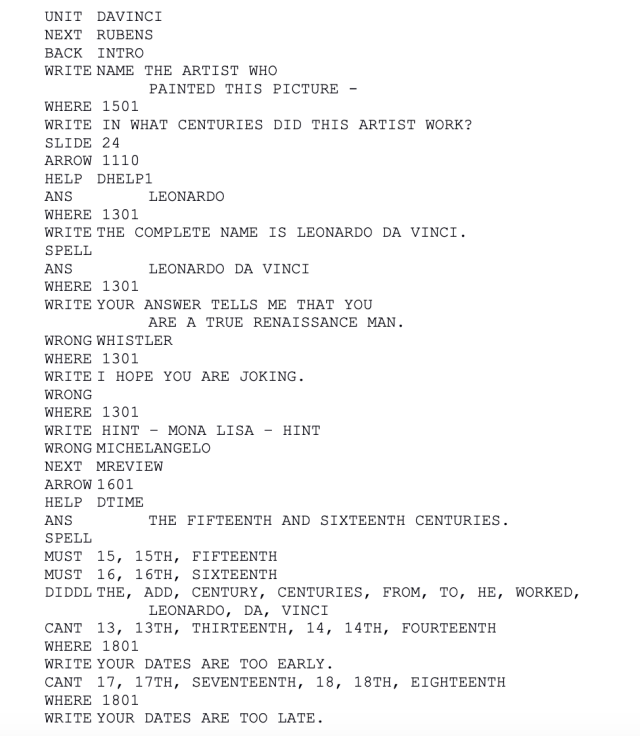
This snippet shows some of the major features of TUTOR, such as its field-based nature (typical of languages of the day, which were still strongly influenced by punch cards) and unit orientation. A unit could be thought of as a slide (and could even specify a particular slide) with text and figures positioned with WHERE, PLOT, and WRITE statements or drawn with LINEs. HELP, NEXT, and BACK statements defined branching flow from unit to unit.
Advertisement
This unit defined two “arrows” where answers were received at particular locations on-screen (an ARROW key on the PLATO III keyboard advanced through them) and defined not only the correct answers (ANS) but words that MUST be present, words that were treated as not salient (DIDDL), and words that CANT be present or are just plain WRONG (including a catch-all for any answer that is incorrect).
Advertisement
Later updates let a specific sentence structure be specified, and the SPELL command even checked for variances in spelling, which, because it was a pedagogical system, would be pointed out to the student. TUTOR programs for PLATO III could store up to 63 typed variables per student as 8-character strings, integers or floating point, and a CALC command allowed computing expressions at runtime. Some of these features are comparable to its better-known contemporary, PILOT, a more typical imperative computer-aided instructional language that evolved into a general-purpose one.
Teachers entered TUTOR programs on a PLATO terminal itself using an editor facility called “author mode.” Author mode was protected by a single global password, so the manual took pains to remind instructors to “[n]ever let any student or other unauthorized individual see how you shift a terminal to AUTHOR MODE.” Besides authoring and loading data to and from disk packs and magnetic tape, an educator could view student progress and print copies. A special “sign in” as a generic STUDENT let an educator preview a lesson, as seen in this mockup of the code above:
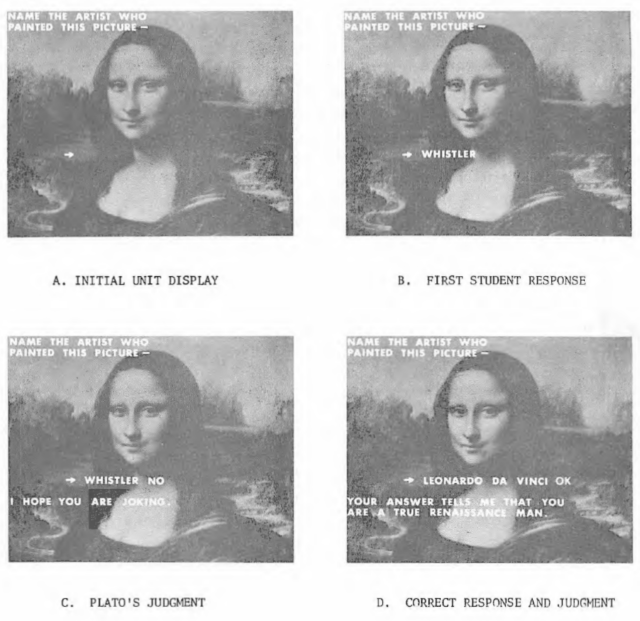
Enlarge / Mona Lisa TUTOR example in action.
A Little History of e-Learning (preprint, Cope & Kalantzis, 2021)
PLATO III supported up to 20 simultaneous users to the CDC 1604, and a PLATO III terminal was the first PLATO terminal to exist off-university at Springfield High School in the Illinois state capital. It had a dedicated video downlink and keyboard data uplink. Courses later served not only the University but also a local nursing school, an elementary school, and a community college. By 1970, there were over 720 hours of courseware available.
Advertisement
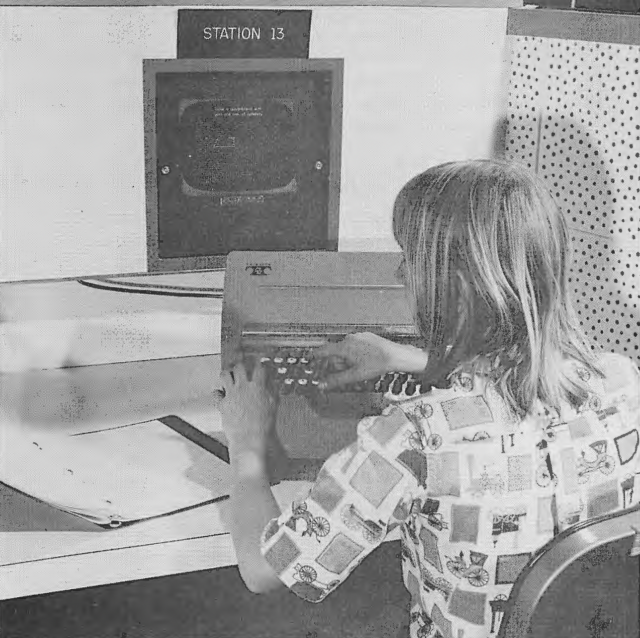
Enlarge / PLATO III terminal in 1969.
X-4 Tutor Manual (Avner & Tenczar, 1969)
Of course, education wasn’t the only thing PLATO III was doing. Spacewar! had made a big splash on the PDP-1 in 1962, and Richard Blomme ported it to the network in 1969 using custom character graphics to draw spaceships instead of vectors. Players could duel each other and pick opponents off a “big board.”
It was by no means the last game PLATO users would play.
PLATO IV: The Voyage Home
But many people would never touch a PLATO terminal until PLATO IV. Ever fascinated by the growing possibilities, CDC’s William Norris next set up UIUC in 1968 with a CDC 6400, the smaller, younger sibling of the 60-bit CDC 6600, widely considered to be the world’s first successful supercomputer. The 6600 was one of the first load-store architectures and had 10 parallel functional units for then-unprecedented levels of parallel execution, beating IBM’s monstrous 7030 Stretch with up to three megaFLOPS at 10 MHz to become the fastest computer in the world from 1964 to 1969 until it was eclipsed by its successor, the CDC 7600.
Advertisement
The 6400 may have been the junior member of the family, but it was certainly no slouch. The only difference was a single unified ALU that was nevertheless fully software-compatible with the same memory, I/O, and output capabilities. Norris couldn’t just give away even the baby flagship to the group, but after a meeting with Don Bitzer and Dan Alpert and mindful of the additional grants coming in, he convinced CDC management to let CERL pay nothing the first year and pay in installments thereafter. This provided more than enough power for what Bitzer planned next.
Advertisement
Critically, the success of PLATO’s earlier iterations yielded a dedicated funding stream for Bitzer’s group at CERL from the National Science Foundation, which specified that the new system should support at least 300 terminals. The TUTOR runtime was duly expanded and ported to the 6400, and with sufficient backend power, Bitzer began greatly increasing the front end’s capabilities.
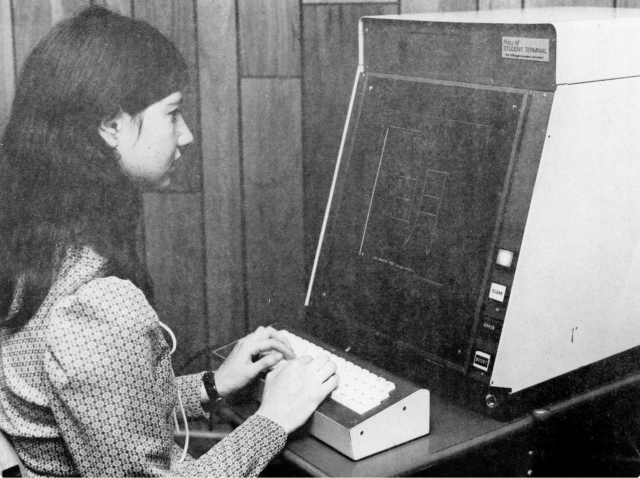
Enlarge / A common Magnavox-manufactured PLATO IV student terminal in 1971.
The PLATO IV Architecture (Stifle, 1971, revised 1972)
Gone was the old cathode-ray storage tube; instead, PLATO IV’s most notable change and enduring feature was a bright orange 512×512 bitmapped gas plasma display first developed in 1964 by Bitzer, electrical engineering professor Gene Slottow, and graduate student Robert Willson. The 8.5-inch-square Digivue display built by glass producer Owens-Illinois in 1971 required no memory nor refresh circuitry, yielding all the advantages of the storage tube but in a durable, flat package with a crisp, high-contrast image. Built-in character and line generators provided hardware-assisted graphics at 180 characters and 600 line-inches per second, using a partially programmable 8×16 252-glyph character set, which student intern Bruce Parello would make into the first digital emoji in 1972.
The display was transparent and could still overlay slides from the projector, which was upgraded to use 4×4-inch microfiche. (Not to be confused with the similar-appearing electroluminescent displays used in systems like the GRiD Compass, orange monochrome gas plasma displays later became popular in the late 1980s and early 1990s for flat-screen portable workstations such as the Compaq Portable 386, the IBM P75, and my personal favorite, the huge 1152×900 garish glow of the 1990 SPARC-based Solbourne S3000. The related Panaplex-style dot matrix plasma display was best known for its wide use in pinball machines until it was replaced by high-intensity LEDs.)

Enlarge / A later 1974 PLATO IV student terminal.
The PLATO CAI System: Where Is It Now? Where Can It Go? (Eastwood & Ballard, 1975)
The user interface also improved. Not only was the keyboard revamped, but the display also featured a 16×16 infrared touch panel to let students directly interact with on-screen elements. PLATO IV branched into sound as well, though less successfully. Although a per-terminal pneumatically controlled magnetic disc could hold up to 17 minutes of analogue audio and 4,096 random-access index points, it was unreliable until a 1980 upgrade, and the 1972 specification called it “optional.”
Advertisement
Fortunately, additional client I/O channels meant future upgrades could be installed as capabilities expanded (for example, the parallel port for the audio disc was also used for the 1974 Gooch Synthetic Woodwinds, a simple four-voice music synthesizer, and the follow-on 16-voice Gooch Cybernetic Synthesizer for PLATO V; it was also used for a Votrax speech synthesizer).
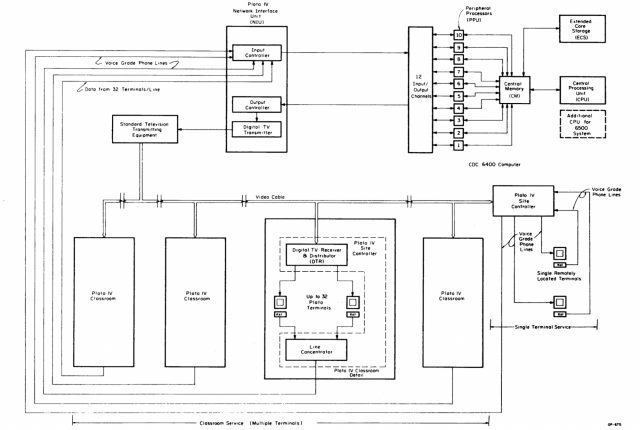
Enlarge / PLATO IV network diagram.
The Plato IV Architecture (Stifle, 1971, revised 1972)
But PLATO IV’s biggest technological leap was probably its massive remote capability, introducing new advances in networking centered on a custom Network Interface Unit (NIU) connected to the CDC 6400. On the server side, course data was stored on a 75-megaword hard disk and three 32 megaword disk packs and was loaded into the 6400’s 64-kiloword central memory and 2-megaword extended core memory to run student sessions. For performance, the extended core served as swap space, not the disks.
The higher-bandwidth downlink from the NIU came via analogue NTSC cable television, using a digital TV receiver and distributor system to demultiplex and serve multiple classroom nodes of up to 32 terminals, each at 1260 bps. Each terminal received a stream of instructions from the receiver/distributor delivered directly to the plasma display and projector; because the terminal could self-maintain its image, no local memory or CPU was required. The lower-bandwidth uplink from each terminal’s keyboard and screen went into the node’s concentrator, which multiplexed their signals and sent them back collectively to the NIU over a single regular voice-grade telephone line, also at 1260 bps.
Advertisement
The downlink/uplink units were collectively referred to as the Site Controller (SC). The 6400’s 12 I/O channels and 10 12-bit peripheral processing units, every bit as powerful as the bigger 6600’s, easily handled the bandwidth of up to 1,008 simultaneous sessions per cable channel, and the use of existing cable and phone lines made network expansion highly feasible. Microwave links could send downlink data en masse to remote sites, or a single remote terminal could receive its own downlink from an SC transmitting over a phone line.
Advertisement
The new terminals were announced as available to all by Bitzer, though the $5,500+ price tag in 1974 per terminal (over $33,000 today) wasn’t particularly egalitarian, and stocks weren’t plentiful. But those who did have access to PLATO had a field day with the new platform, and the freewheeling atmosphere at CERL encouraged new ideas. Besides the notional educational content, a simple message system called “-pad-” sprang up in 1973—implemented as a TUTOR “lesson”—and the concept expanded into the general-purpose Talkomatic group chat written by programmer Doug Brown and later the Term-Talk private chat (named after the TERM key to trigger it).
Ostensibly, such features allowed administrators, teachers, and students to communicate productively, consistent with PLATO’s educational aims. But PLATO’s response time was so swift that messaging was practically instantaneous and became highly addictive, and system usage skyrocketed as a result; users hung out in channels waiting for people to drop by to talk to (or sometimes to flirt with). It was a level of interactivity few had ever experienced before, and it represented some of the first social interactions communicated entirely via computer.

Enlarge / A 1973 Talkomatic session.
A Little History of e-Learning (preprint, Cope and Kalantzis, 2021)
Another lasting idea came from 16-year-old student employee David Woolley, who developed the 1973 PLATO Notes bulletin-board system. Originally a project Paul Tenczar assigned him for bug reporting, the system grew into a general message board and then into Kim Mast’s private Personal Notes (“PNOTES”) by the end of 1974, or what we would now call an early form of email. The later Lotus Notes took its name and inspiration from it. Some of its public posts survive in printed form, such as this exchange from January 3, 1974, currently the earliest in the University’s archive:
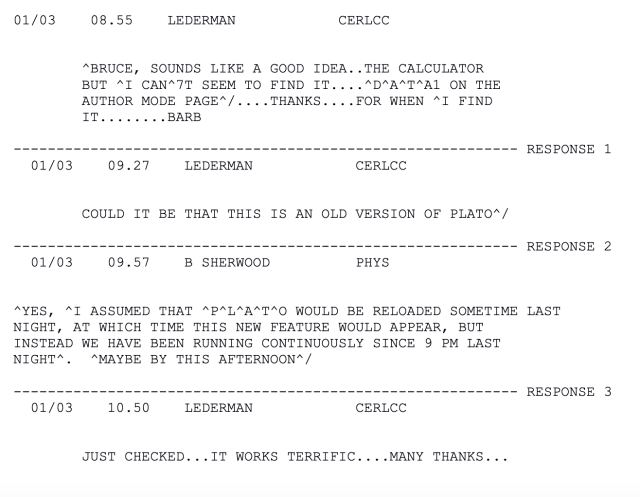
This line printer was incapable of shifted characters, so the ^ indicated a shift (^7 would be apostrophe on the common non-Selectric keyboards of the day, for example, and ^/ would be a question mark). Infamously, PLATO Notes even inspired early consternation over network censorship during Watergate when the NSF got wind of a Notes discussion about President Nixon’s possible impeachment and promptly called Bitzer (“We just got a call from Nixon’s office. The White House says that our money will disappear if this goes ahead, and we know you’ll disappear…”). Bitzer required the student who started the discussion to post a disclaimer that “it is not permissible in the classroom or on PLATO to organize political mobilization.”
Advertisement
Games started appearing on the system as well. Early PLATO IV users flocked to “big board” listings from which players could choose opponents for chess, dogfighting, and card games, but subsequent diversions were more sophisticated. These included a 1974-5 TUTOR implementation of Dungeons & Dragons (‘dnd’) with the first known game boss and an early roguelike with the opaque name ‘pedit5’ (named after the program slot it was saved to), which author Rusty Rutherford constantly restored despite administrators’ repeated attempts to delete it. There was also 1973’s Empire I, probably the first networked multiplayer arena shooter, written by Iowa State student John Daleske in TUTOR with the assistance of Silas Warner at Indiana University over -pad-. (Silas Warner, inspired by other dungeon games on the platform, later became famous as the designer of Castle Wolfenstein for Muse Software.)
The first 3D flight simulator, Air Race, ran on PLATO IV in 1974; it was also the first multiplayer flight simulator and is believed to be a major influence on UIUC student Bruce Artwick’s home computer Flight Simulator series (itself the ancestor of Microsoft Flight Simulator). Back in Urbana, local high school users started blocking senior users from signing on after hours so they could run large multiplayer games. The problem snowballed to such an extent that Urbana police subsequently asked Bitzer to institute a 9 pm curfew for users under the age of 16. A background program nicknamed “The Enforcer” sought out game sessions during high usage and tried to terminate or disable them with varying success as users started to obfuscate their activities.
As PLATO IV approached commercial quality, the new innovations further interested William Norris at CDC, not only because of the enhanced potential to address social inequity through education but also as a possible new line of business. Norris was increasingly convinced (correctly) that the company needed to diversify from its core hardware concern, especially when chief designer Seymour Cray left to form his own eponymous company in 1972, and he saw PLATO as a means to immediately grow the company’s services portfolio. In 1971, Norris set up a new CDC Educational Department specifically to develop PLATO applications, dogfooding the technology by converting over the corporation’s own training and technical manuals. By 1974, CDC had its own PLATO instance running at its Minneapolis headquarters.
Advertisement
In 1976, PLATO had grown to 950 terminals and more than 3,500 hours of instructional material in 100 subjects, served by three instances at UIUC, Florida State University, and CDC itself. UIUC’s instance, now on a donated Cyber 73-2 (an updated equivalent of the CDC 6500 with two one-MIPS CPUs), alone serviced almost 150 locations, including over 30 other colleges and universities. Capacity was getting tight, and Norris made his move. In return for a new top-of-the-line CDC Cyber, Norris wanted all rights to PLATO, period. The University agreed, executing separate agreements on course content, software, and patent licensing, and CERL staff went to the CDC Educational Department to help train them (some stayed on permanently).
Advertisement
The agreement did not terminate CERL, nor did it end Bitzer’s involvement with the project. The agreement permitted CERL to still attract and serve smaller customers, and it continued to do so. As improved microprocessor technology emerged, CERL upgraded the PLATO IV terminal in 1977 with an onboard Intel 8080 CPU, 8K ROM, and 8K RAM that could have code pushed to it by the server; these enhanced terminals—really, early microcomputers—were dubbed “PLATO V” and were the last of the standalone, purpose-built PLATO terminals. Enthusiasts today regard the PLATO V terminals, manufactured by Carroll, as the pinnacle of the design.
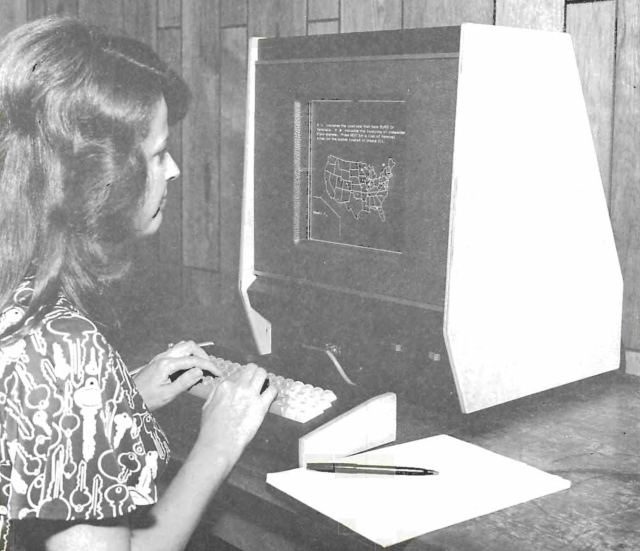
Enlarge / PLATO V terminal in 1977.
The PLATO V Terminal (Stifle, 1977)
For his part, Norris’ belief in PLATO was genuine, and he tirelessly promoted CDC’s new acquisition, declaring that by 1985, it would make up half of the company’s income. CDC even tolerated the games and social applications to a certain extent, considering them value adds, though many clients disabled them. For a variety of reasons, however, CDC used little of the existing content and developed its own over the next several years at sometimes great expense. Some were honorable (re-training unemployed workers for new fields; various courses for inner-city schools), and some were unusual (a farmer crop information system, an Ojibwe Native American language trainer), but despite heavy marketing campaigns, none were highly profitable, even among the large government and corporate customers willing to buy.
Advertisement
The high rates CDC charged clients to recover their operating costs, as well as CDC’s lack of expert courseware writers for some subject areas, were no doubt significant factors. One of its few education successes was online proctored testing, originally developed for the National Association of Security Dealers (today’s FINRA); it was subsequently spun off in 1990 to become the modern Thomson Prometric.
Meanwhile, the microcomputer age was arriving, and Norris decided to take one more leap. It was time to bring PLATO home.
Advertisement
Phenomenal cosmic potential, itty bitty memory space
PLATO V was, of course, technically already a microcomputer, but the terminal-server concept died hard. CERL still sold its own terminals, and CDC started producing the CRT-based IST (“Information System Terminal”) in 1978, but its initial $6,000 price tag (over $24,000 today) made it highly unattractive outside of corporate environments. It was as much an access point for CDC’s other timesharing services as anything else. If PLATO was going to hit the home market, it would simply have to cut the cord. Home computers were also ill-suited to running the length and breadth of what TUTOR was capable of; few could even match the screen resolution, and almost none of them were networked.
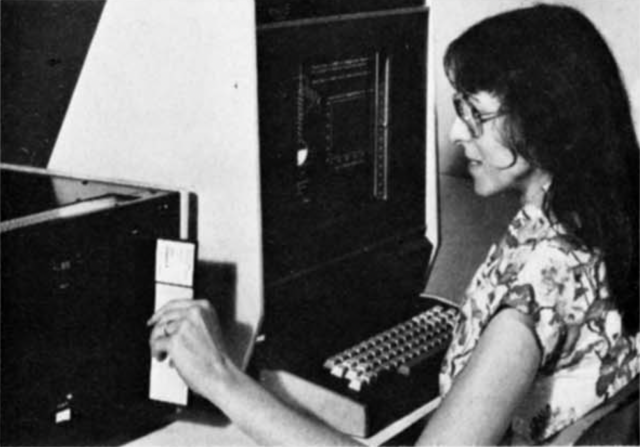
Enlarge / Standalone PLATO V with 8-inch floppy disk drive in 1979.
Computer-Aided Instruction with Microcomputers (Moore et al., 1979)
In 1979, CERL partnered with CDC to develop the Off-Line PLATO System, an add-on to the PLATO V. Instead of a distant minicomputer managing the session, the V’s 8080 CPU ran everything locally, with lessons on floppy disk. The add-on loaded a list of lessons from the disk and presented students with a menu. A demand paging system read program code and data from the floppy with a latency of approximately a tenth of a second, and variables and student data could be stored on the disk as well.
Even with this concession, there was still no way the PLATO V’s 8-bit CPU with 8K of RAM could handle the entirety of the TUTOR runtime, so CERL pared down TUTOR into μ-TUTOR (Micro-TUTOR), a precompiled bytecode version of TUTOR optimized for paging on small systems. Micro-TUTOR could be written and tested on a full PLATO installation and then compiled for the Off-Line System; lessons distributed in this manner were dubbed Micro-PLATO. The authoring platform evolved into CDC’s PLATO Courseware Development and Delivery system PCD2 (the analogous PCD1 didn’t even need access to PLATO) and later the Micro PLATO Authoring System (MPAS).
Advertisement
CDC’s IST-II and IST-III terminals could load and run Micro-TUTOR lessons directly from disks, too, but CDC didn’t sell them as microcomputers. Officially, the first explicit microcomputer to run Micro-PLATO was CDC’s first desktop, the 1981 CDC 110. Like the IST machines it was descended from, it was essentially an overgrown terminal with a Zilog Z80 CPU, 64K of memory, and floppy drives, and BASIC, Pascal, and CP/M were options.
It not only could load offline lessons but still had firmware to dial into PLATO or CDC’s Cybernet and Call 370 timesharing services. CDC didn’t target these machines to home users, either; the ticket price alone was $4,995 (about $16,200 today), plus anywhere from $425 to as much as $4,000 for software, and CDC sold them from its own network of retail Business Centers. The CDC 110’s most immediate descendant was the CDC “Viking” 721, which retained PLATO compatibility.
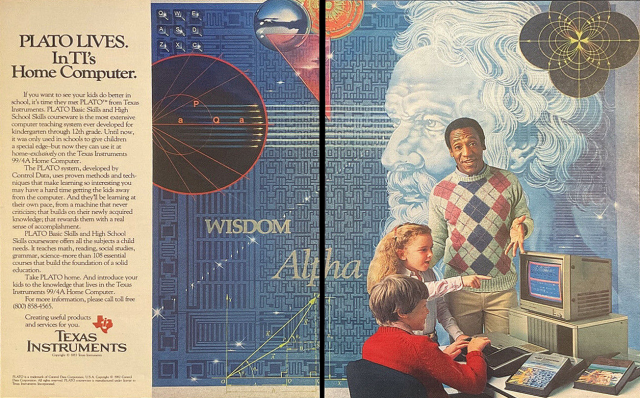
Enlarge / A seriously dated 1982 Texas Instruments ad.
Instead, the first true home computer port came from Texas Instruments, the first non-CERL, non-CDC machines to run Micro-TUTOR. Texas Instruments was getting deep in the weeds at this point from its protracted market battle with Jack Tramiel’s Commodore Business Machines, and in an effort to elevate itself above its nemesis, the company embarked on the port itself with CDC’s permission in 1981.
Ironically, being a 16-bit system based on the minicomputer-derived 9900 CPU, the Texas Instruments 99/4A was closer to the capabilities of PLATO’s servers than any other home computer at the time, but it still had steep system requirements. The need for a floppy disk drive meant that 99/4A owners had to own an expensive Peripheral Expansion Box as well as the entry-level computer. Released in 1982, the system was strongly modeled on the Off-Line System using a “PLATO in a cartridge” interpreter to run Micro-TUTOR lessons from floppy disk, authored with the new PCD2 system for the lower 256×192 resolution of the 9918 VDP.
Advertisement
CDC’s sole involvement with the TI effort was technical advice and transferring the Micro-TUTOR code to the TI’s floppy disk format; the rest was entirely written by TI. Later that year, however, a different set of Micro-TUTOR courses was announced by CDC itself. A pack of nine courses (basic math, physics, French, German, Spanish, and computer literacy) was announced not only for the “PLATO in a cartridge” TI system, adding to its library, but also for the MOS 6502-based Apple II and Atari 800.
Unlike the TI port, however, the Apple and Atari Micro-PLATO ports were converted to run directly on the computer, and no separate Micro-TUTOR interpreter was used. At $45 for the first lesson and $35 for each additional, the price was high, but PLATO had at last reached home retail. For its part, TI advertised over 100 coursescontaining over 450 individual lessons by 1983, but it never became more than a niche feature for a struggling system and wasn’t enough to save the home computer line.
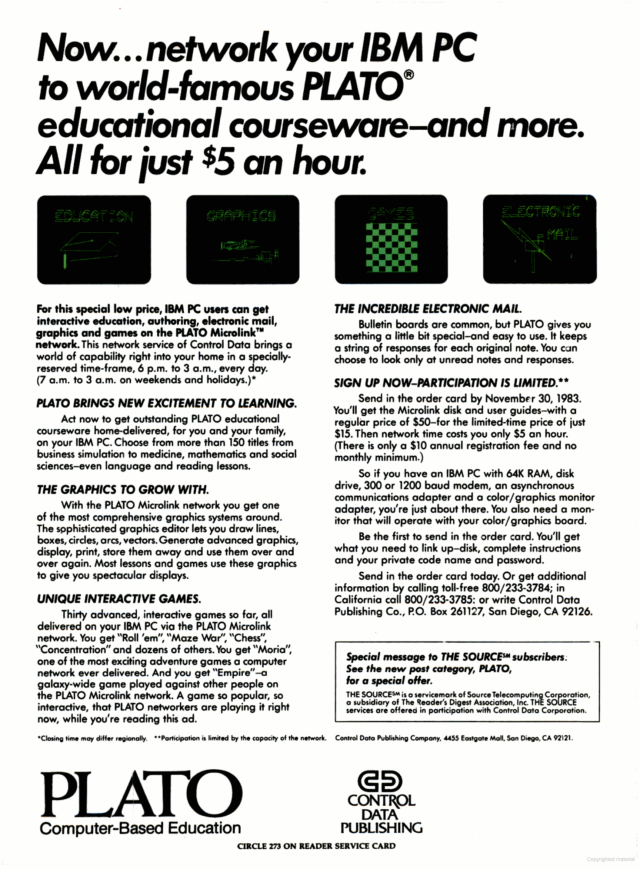
Enlarge / CDC PLATO Microlink ad, November 1983.
CDC tried another tack in 1983 with PLATO Microlink, this time for the IBM PC. Systems with 64K of RAM, a graphics adapter, and a 300 or 1200 baud modem could be turned into PLATO terminals with CDC’s $50 software package, accessing PLATO for a $10 signup fee and $5 an hour during specified times (plus phone charges). Games, messaging, and courseware were all part of the product.
Advertisement
CDC had just been brought on as an investor of online service The Source, and as an enticement to customers who already had online capability, the company offered existing Source subscribers free signup for PLATO. (Although rumors suggested The Source itself would offer PLATO content, this never happened by the time CDC extricated itself from the partnership in 1987.) Inexplicably, despite PC graphic adapters of the time being perfectly capable of using a 512×512 display, the PC client displayed at a scaled 512×256.
Advertisement
Atari, meanwhile, had been working on its own PLATO terminal software as far back as 1981. An early prototype in December of that year became the first non-PLATO microcomputer to access the network, but the unilateral release of CDC’s Micro-PLATO software for the Atari soured the relationship, and negotiations broke down in early 1983. Developer Vincent Wu continued to work on the project on his own time, and when PC Microlink emerged, he was able to convince Atari and CDC management to come back to the table.
Finally released in 1984, the Atari PLATO cartridge (named “The Learning Phone”) was explicitly targeted at the home market to avoid cannibalizing PC client sales; CDC resold the PLATO Microlink service to Atari users under the name “PLATO Homelink” for the same price. Like PC Microlink, the Atari PLATO cartridge accessed real PLATO servers via modem and national packet-switched networks. ANTIC’s highest supported resolution was 320×192, so Wu implemented a virtual screen system to either downscale the standard PLATO 512×512 display or zoom in on portions of it. The touchscreen was even emulated with a joystick, making it more compatible with more PLATO lessons than PC Microlink, which had no such capability.
Three uneasy PLATO pieces
Despite these and other efforts, PLATO failed to gain traction in the home market, and amid substantial financial turmoil at CDC, William Norris stepped down as CEO in 1986. PLATO’s foundering wasn’t the only thing damaging CDC’s bottom line, but observers agreed it was a notable part of it. Norris alleged Micro-TUTOR and Micro-PLATO got the project off track and blamed poor market choices with TI and Atari for its woes. Indeed, the Apple II never got a native PLATO or Micro-PLATO client despite its ubiquitous presence in American schools, nor did the Commodore 64, then the dominant leader in the home market. Don Bitzer was less charitable, blaming CDC’s ossified governance structure and excessively high content development costs for PLATO’s decline instead.
In an attempt to reorganize, new CEO Lawrence Perlman began liquidating assets, including the Commercial Credit Corporation branch in 1986 (to become Citigroup), their portion of The Source in 1987 (killed by CompuServe), and Ticketron in 1990 (now part of Ticketmaster). In 1989, CDC sold the PLATO trademark and a portion of its courseware markets to investor William Roach and his Roach Organization, which renamed it TRO Learning in 1992 and focused on corporate training. Despite being renamed again to PLATO Learning in 2000, PLATO sensu stricto was never used by the company, and very little of the original divestment actually persisted. It was eventually renamed a final time to Edmentum in 2012 and is still in business today, primarily serving school districts.
Advertisement
Microlink having already been shut down, the remaining portion of PLATO at CDC was renamed to CYBIS (CY-ber Based Instructional System) to service the company’s existing commercial and government contracts. In 1992, CDC spun out its computer services line as Control Data Systems, which eventually sold CYBIS in 1994 to startup University Online, Inc. UOL renamed itself to VCampus in 1996 and subsequently went out of business (the domain name today is parked).
CDS was absorbed into BT (the former British Telecom) in 1999, marking the end of Control Data’s technology under that name. CDC’s last true surviving successor after the breakup is HR services and software corporation Ceridian, today still in operation in CDC’s old home town of Minneapolis.
In the midst of all this, the CERL group at UIUC continued to quietly maintain its academic customers and develop its own courseware as permitted by the 1976 agreement with CDC. In 1985, CERL founded the for-profit business University Communications, Inc. (UCI) to monetize those operations. The most lasting remnant to emerge from this twilight was NovaNET, which expanded the cable TV-based downlink from the PLATO instance to the classroom with a new satellite option (a modem still provided the uplink) and serviced an increasingly diverse clientele that even included juvenile halls.
Advertisement
Unfortunately for CERL, Don Bitzer’s departure from the university in 1989 meant the group had lost its most ardent defender, and CERL was disbanded in 1994. UCI itself was spun off entirely from the university and reincorporated as NovaNET Learning. This initial piece was bought by National Computer Systems, and then NCS itself was bought by Pearson Education in 1999.
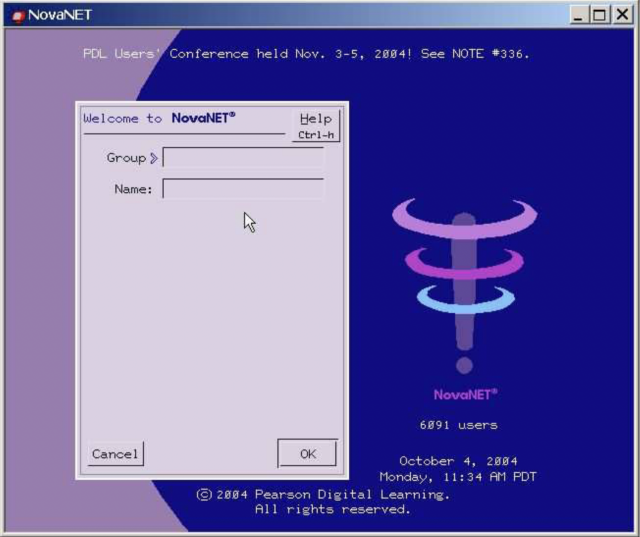
Enlarge / NovaNET sign-on with Windows client in 2004.
The PLATO Computer System (Eckhardt & Maggs)
While some form of TUTOR still underlaid the system, NovaNET enhanced it most notably with a more modern user interface and greater multimedia capabilities delivered over a conventional LAN via an updated Microsoft Windows client. Its biggest success was in alternative education, where Pearson marketed the “learn at your own pace” architecture to students poorly served by a conventional classroom experience (actual research on its effectiveness was somewhat more equivocal). As PCs became individually more powerful, however, and courseware transitioned to fat clients and web-based trainings, the proprietary centralized nature of NovaNET’s offering became an increasing disadvantage, and customers gradually left the network. In 2015, Pearson decommissioned NovaNET, the last of the direct PLATO descendants.
PLAy TOday
But even if you weren’t around for PLATO in its prime, that doesn’t mean you’ll never get to experience it. After VCampus went under, the business and assets reverted to its former CEO, who granted permission for a non-commercial release of CYBIS. One such instance is Cyber1, which maintains a public instance accessible over the Internet using the open source PTerm client, available for Windows, macOS (including Power Macs), and Linux. PTerm adds color support and can even execute Micro-TUTOR lessons from disk images. Much of the experience from PLATO’s heyday, including its famous games, are available.
More interested in the backend? Run your own installation on top of the dtCYBER package, which emulates a CDC 6600-compatible Cyber 175. The package includes a CYBIS disk image with CDC’s NOS operating system, a boot tape image, and PTerm.
And if you want a more modern retrocomputing take, IRATA.ONLINEis a PLATO-based system with new content focused on old machines, starting originally with clients for Atari 8-bits (including, with interfacing, Atari’s old 1984 cartridge, but also FujiNet) and now Apple II and IIGS, Commodore 64 and 128 (VDC supported for full resolution), IBM 5150 PC and PCjr, ZX Spectrum (serial or Spectranet), Atari ST, Amiga, TI 99/4A, and many more. It also works with PTerm, and source code is available.
PLATO’s contributions to computer-aided education can’t be overemphasized, but the advances to make those contributions possible led to critical innovations in many other technical fields as well, such as graphic displays, networking, and user interfaces. In addition, the creativity of its users and its early freewheeling environment combined to yield groundbreaking academic content, highly influential games, and pioneering social and messaging tools that were the conceptual forerunners of the applications we use now and set in motion the cultural underpinnings of our ubiquitously networked modern world.
Thanks to the dedicated preservationists maintaining the software and committing its rich history to posterity, PLATO lives on to teach, inspire, and entertain today’s generation and the generations to come, even years after the organizations that spawned it have faded away.
Cameron Kaiser works in public health by day and in a wonderland of geriatric technology by night. His lab in Southern California is likely where your old computer lives again. Read about his other retrocomputing adventures at Old Vintage Computing Research.